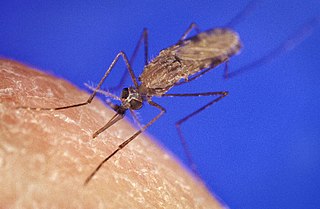Related Research Articles

An olfactory receptor neuron (ORN), also called an olfactory sensory neuron (OSN), is a sensory neuron within the olfactory system.
Olfactory receptors (ORs), also known as odorant receptors, are chemoreceptors expressed in the cell membranes of olfactory receptor neurons and are responsible for the detection of odorants which give rise to the sense of smell. Activated olfactory receptors trigger nerve impulses which transmit information about odor to the brain. These receptors are members of the class A rhodopsin-like family of G protein-coupled receptors (GPCRs). The olfactory receptors form a multigene family consisting of around 800 genes in humans and 1400 genes in mice.

DSCAM and Dscam are both abbreviations for Down syndrome cell adhesion molecule. In humans, DSCAM refers to a gene that encodes one of several protein isoforms.
The antennal lobe is the primary olfactory brain area in insects. The antennal lobe is a sphere-shaped deutocerebral neuropil in the brain that receives input from the olfactory sensory neurons in the antennae and mouthparts. Functionally, it shares some similarities with the olfactory bulb in vertebrates. The anatomy and physiology function of the insect brain can be studied by dissecting open the insect brain and imaging or carrying out in vivo electrophysiological recordings from it.
Icaridin, also known as picaridin, is an insect repellent which can be used directly on skin or clothing. It has broad efficacy against various insects such as mosquitos, ticks, gnats, flies and fleas, and is almost colorless and odorless. A study performed in 2010 showed that picaridin spray and cream at the 20% concentration provided 12 hours of protection against ticks. Icaridin does not dissolve plastics, synthetics or sealants.

The Anopheles gambiae complex consists of at least seven morphologically indistinguishable species of mosquitoes in the genus Anopheles. The complex was recognised in the 1960s and includes the most important vectors of malaria in sub-Saharan Africa, particularly of the most dangerous malaria parasite, Plasmodium falciparum. It is one of the most efficient malaria vectors known. The An. gambiae mosquito additionally transmits Wuchereria bancrofti which causes lymphatic filariasis, a symptom of which is elephantiasis.
Odorant-binding proteins (OBPs) are small soluble proteins secreted by auxiliary cells surrounding olfactory receptor neurons, including the nasal mucus of many vertebrate species and in the sensillar lymph of chemosensory sensilla of insects. OBPs are characterized by a specific protein domain that comprises six α-helices joined by three disulfide bonds. Although the function of the OBPs as a whole is not well established, it is believed that they act as odorant transporters, delivering the odorant molecules to olfactory receptors in the cell membrane of sensory neurons.

1-Octen-3-ol, octenol for short and also known as mushroom alcohol, is a chemical that attracts biting insects such as mosquitoes. It is contained in human breath and sweat, and it was once believed that insect repellent DEET worked by blocking the insects' octenol odorant receptors. Recent evidence in Anopheles gambiae and Culex quequinfasciatius mosquitoes suggest DEET reduces the volatility of 1-octen-3-ol which can result in a reduction in human attraction. 1-Octen-3-ol is a secondary alcohol derived from 1-octene. It exists in the form of two enantiomers, (R)-(–)-1-octen-3-ol and (S)-(+)-1-octen-3-ol.

Olfactory receptor 1G1 is a protein that in humans is encoded by the OR1G1 gene.

The sense of smell, or olfaction, is the special sense through which smells are perceived. The sense of smell has many functions, including detecting desirable foods, hazards, and pheromones, and plays a role in taste.

Leslie Birgit Vosshall is an American neurobiologist and currently an Howard Hughes Medical Institute (HHMI) Investigator and the Robin Chemers Neustein Professor of Neurogenetics and Behavior at The Rockefeller University. In 2022 she was appointed Chief Scientific Officer and vicepresident of HHMI. She is also the director of the Kavli Neural Systems Institute at The Rockefeller University. She is well known for her contributions to the field of olfaction, particularly for the discovery and subsequent characterization of the insect olfactory receptor family, and the genetic basis of chemosensory behavior in mosquitoes and humans.

A genetically modified (GM) insect is an insect that has been genetically modified, either through mutagenesis, or more precise processes of transgenesis, or cisgenesis. Motivations for using GM insects include biological research purposes and genetic pest management. Genetic pest management capitalizes on recent advances in biotechnology and the growing repertoire of sequenced genomes in order to control pest populations, including insects. Insect genomes can be found in genetic databases such as NCBI, and databases more specific to insects such as FlyBase, VectorBase, and BeetleBase. There is an ongoing initiative started in 2011 to sequence the genomes of 5,000 insects and other arthropods called the i5k. Some Lepidoptera have been genetically modified in nature by the wasp bracovirus.

Vomeronasal receptors are a class of olfactory receptors that putatively function as receptors for pheromones. Pheromones have evolved in all animal phyla, to signal sex and dominance status, and are responsible for stereotypical social and sexual behaviour among members of the same species. In mammals, these chemical signals are believed to be detected primarily by the vomeronasal organ (VNO), a chemosensory organ located at the base of the nasal septum.

In molecular biology, the insect pheromone-binding family A10/OS-D is a family of small helical proteins postulated to contribute to the specificity of the insect’s olfactory system by binding components of the natural pheromone mixtures.
Junhyong Kim is the Edmund J. and Louise W. Kahn Term Endowed Professor of Biology at the University of Pennsylvania and the author of over eighty published scientific papers.
Or83b, also known as Orco, is an odorant receptor and the corresponding gene that encodes it. The odorant receptor Or83b is not exclusively expressed in insects. Though its actual function is still a mystery, the broadly expressed Or83b has been conserved across highly divergent insect populations across 250 million years of evolution.

Insect olfaction refers to the function of chemical receptors that enable insects to detect and identify volatile compounds for foraging, predator avoidance, finding mating partners and locating oviposition habitats. Thus, it is the most important sensation for insects. Most important insect behaviors must be timed perfectly which is dependent on what they smell and when they smell it. For example, olfaction is essential for locating host plants and hunting prey in many species of insects, such as the moth Deilephila elpenor and the wasp Polybia sericea, respectively.
Q-system is a genetic tool that allows to express transgenes in a living organism. Originally the Q-system was developed for use in the vinegar fly Drosophila melanogaster, and was rapidly adapted for use in cultured mammalian cells, zebrafish, worms and mosquitoes. The Q-system utilizes genes from the qa cluster of the bread fungus Neurospora crassa, and consists of four components: the transcriptional activator (QF/QF2/QF2w), the enhancer QUAS, the repressor QS, and the chemical de-repressor quinic acid. Similarly to GAL4/UAS and LexA/LexAop, the Q-system is a binary expression system that allows to express reporters or effectors in a defined subpopulation of cells with the purpose of visualising these cells or altering their function. In addition, GAL4/UAS, LexA/LexAop and the Q-system function independently of each other and can be used simultaneously to achieve a desired pattern of reporter expression, or to express several reporters in different subsets of cells.
Insect olfactory receptors are expressed in the cell membranes of the olfactory sensory neurons of insects. Similarly to mammalian olfactory receptors, in insects each olfactory sensory neuron expresses one type of OR, allowing the specific detection of a volatile chemical. Differently to mammalian ORs, insect ORs form a heteromer with a fixed monomer, Orco, and a variable OR monomer, which confers the odour specificity.

Reinhard F. Stocker is a Swiss biologist. He pioneered the analysis of the sense of smell and taste in higher animals, using the fly Drosophila melanogaster as a study case. He provided a detailed account of the anatomy and development of the olfactory system, in particular across metamorphosis, for which he received the Théodore-Ott-Prize of the Swiss Academy of Medical Sciences in 2007, and pioneered the use of larval Drosophila for the brain and behavioural sciences.
References
- ↑ "John R Carlson".
- ↑ "Chemosensory Perception in Insects".
- ↑ Clyne, P. J.; Warr, C. G.; Freeman, M. R.; Lessing, D.; Kim, J.; Carlson, J. R. (February 1999). "A novel family of divergent seven-transmembrane proteins: candidate odorant receptors in Drosophila". Neuron. 22 (2): 327–338. doi: 10.1016/S0896-6273(00)81093-4 . ISSN 0896-6273. PMID 10069338.
- ↑ Clyne, P. J.; Warr, C. G.; Carlson, J. R. (2000-03-10). "Candidate taste receptors in Drosophila". Science. 287 (5459): 1830–1834. doi:10.1126/science.287.5459.1830. ISSN 0036-8075. PMID 10710312.
- ↑ Dobritsa, Anna A.; van der Goes van Naters, Wynand; Warr, Coral G.; Steinbrecht, R. Alexander; Carlson, John R. (2003-03-06). "Integrating the molecular and cellular basis of odor coding in the Drosophila antenna". Neuron. 37 (5): 827–841. doi: 10.1016/S0896-6273(03)00094-1 . ISSN 0896-6273. PMID 12628173.
- ↑ Hallem, Elissa; Carlson, John (April 2006). "Coding of Odors by a Receptor Repertoire". Cell. 125 (1): 143–160. doi: 10.1016/j.cell.2006.01.050 . PMID 16615896.
- ↑ Carey, Alison; Wang G; Su CY; Zwiebel LJ; Carlson JR. (March 4, 2010). "Odorant reception in the malaria mosquito Anopheles gambiae". Nature. 464 (7285): 66–71. doi:10.1038/nature08834. PMC 2833235 . PMID 20130575.
- ↑ Carlson, John; Alison Carey (July 2011). "Scent of a Human: The Battle against Mosquitoes". Scientific American. 305 (1): 76–79. doi:10.1038/scientificamerican0711-76. PMID 21717963.
- ↑ "John Carlson".
- 1 2 "John Carlson - John Simon Guggenheim Memorial Foundation". Archived from the original on 2012-05-07.
- ↑ "NAS Members and Foreign Associates Elected". National Academy of Sciences. Archived from the original on May 4, 2012. Retrieved May 2, 2012.
- ↑ "New 2012 Academy Members by Alphabetical Index" (PDF). American Academy of Arts and Sciences. Retrieved May 2, 2012.
- ↑ Anholt, Robert (April 2011). "The 2011 Genetics Society of America Medal: John Carlson". Genetics. 187 (4): 991. doi:10.1534/genetics.111.127845. PMC 3070535 . Retrieved May 2, 2012.